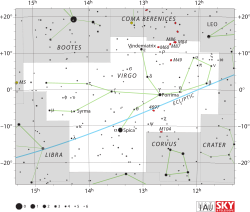Ny Virginis
| Ny Virginis (ν) | |
 | |
| Observationsdata Epok: J2000 | |
|---|---|
| Stjärnbild | Jungfrun |
| Rektascension | 11t 45m 51,55957s[1] |
| Deklination | +06° 31′ 45,7413″[2] |
| Skenbar magnitud () | +4,04[3] 4,1-4,16 (p)[4] |
| Stjärntyp | |
| Spektraltyp | M1 III[2] |
| U–B | 1,80[3] |
| B–V | 1,501 ± 0,032[5] |
| Variabeltyp | Halvregelbunden variabel (SRB)[4] |
| Astrometri | |
| Radialhastighet () | +50,19 ± 0,30[6] km/s |
| Egenrörelse (µ) | RA: -18,96[1] mas/år Dek.: -181,56[1] mas/år |
| Parallax () | 11,10 ± 0,18[1] |
| Avstånd | 294 ± 5 lå (90 ± 1 pc) |
| Absolut magnitud () | -0,87[7] |
| Detaljer | |
| Massa | 1,6[8] M☉ |
| Radie | 54[6] R☉ |
| Luminositet | 631[6] L☉ |
| Temperatur | 4 009[8] K |
| Metallicitet | 0,06[6] |
| Vinkelhastighet | 3,8[6] km/s |
| Andra beteckningar | |
| 3 Virginis, GCRV 7128, JP11 2086, RAFGL 1509, GEN# +1.00102212, LSPM J1145+0631, SAO 119035, GSC 00278-00925, 2MASS J11455155+0631456, SKY# 22240, AG+06 1460, HD 102212, N30 2741, TYC 278-925-1, ASCC 1042440, HIC 57380, NLTT 28465, UBV 10599, BD+07 2479, HIP 57380, NSV 5318, UBV M 17357, CSV 102676, HR 4517, PLX 2720, USNO-B1.0 0965-00206336, DO 3143, IRAS 11432+0649, PLX 2720.00, YZ 6 5910, FK5 1302, IRAS 11432+0648, PMC 90-93 899, DS98 160, GC 16135, IRC +10245, PPM 158181[2] | |
Ny Virginis (ν Virginis förkortat Ny Vir, ν Vir), som är stjärnans Bayer-beteckning, är en ensam stjärna i den västra delen av stjärnbilden Jungfrun. Den har en genomsnittlig skenbar magnitud på +4,04[3] och är synlig för blotta ögat där ljusföroreningar ej förekommer. Baserat på parallaxmätningar i Hipparcos-uppdraget på 11,1[1] mas beräknas den befinna sig på ca 294 ljusårs (90 parsek) avstånd från solen. Eftersom stjärnan ligger nära ekliptikan, kan den bli förmörkad av månen.[9]
Egenskaper
[redigera | redigera wikitext]Ny Virginis är en röd till orange jättestjärna av spektralklass M1 III.[10] Den har en massa som är ca 1,6[8] gånger solens massa, en radie som är ca 54[6] gånger större än solens och utsänder ca 630[6] gånger mera energi än solen från dess fotosfär vid en effektiv temperatur på ca 4 000 K.[8]
Ny Virginis, eller 3 Virginis, är en halvregelbunden variabel av SRB-typ. Den varierar mellan fotografisk magnitud +4,1 och 4,16 med variationer i fyra perioder med en längd av 11,1, 12,3, 16,8 och 23,7 dygn.[11]
Se även
[redigera | redigera wikitext]Referenser
[redigera | redigera wikitext]- Den här artikeln är helt eller delvis baserad på material från engelskspråkiga Wikipedia, Nu Virginis, 26 mars 2019.
Noter
[redigera | redigera wikitext]- ^ [a b c d e] van Leeuwen, F. (2007), "Validation of the new Hipparcos reduction", Astronomy and Astrophysics, 474 (2): 653–664, arXiv:0708.1752, Bibcode:2007A&A...474..653V, doi:10.1051/0004-6361:20078357.
- ^ [a b c] ”Basic data: V* nu. Vir – Long-period variable star” (på engelska). Centre de Données astronomiques de Strasbourg. http://simbad.u-strasbg.fr/simbad/sim-basic?Ident=3+Vir&submit=SIMBAD+search. Läst 8 augusti 2017.
- ^ [a b c] Mermilliod, J.-C. (1986), "Compilation of Eggen's UBV data, transformed to UBV (unpublished)", Catalogue of Eggen's UBV data, SIMBAD, Bibcode:1986EgUBV........0M.
- ^ [a b] ”Nu. Vir” (på engelska). The International Variable Star Index. AAVSO – American Association of Variable Star Observers. http://www.aavso.org/vsx/index.php?view=detail.top&oid=38124. Läst 8 augusti 2017.
- ^ van Leeuwen (2007). ”Hipparcos, the New Reduction” (på engelska). http://vizier.u-strasbg.fr/viz-bin/VizieR-5?-out.add=.&-source=I/311/hip2&HIP=57380. Läst 8 augusti 2017.
- ^ [a b c d e f g] Massarotti, Alessandro; et al. (January 2008), "Rotational and radial velocities for a sample of 761 HIPPARCOS giants and the role of binarity", The Astronomical Journal, 135 (1): 209–231, Bibcode:2008AJ....135..209M, doi:10.1088/0004-6256/135/1/209.
- ^ Pace, G.; et al. (April 2003), "The Wilson-Bappu effect: A tool to determine stellar distances", Astronomy and Astrophysics, 401: 997–1007, arXiv:astro-ph/0301637, Bibcode:2003A&A...401..997P, doi:10.1051/0004-6361:20030163.
- ^ [a b c d] Tsuji, Takashi (May 2007). "Isotopic abundances of Carbon and Oxygen in Oxygen-rich giant stars". In Kupka, F.; Roxburgh, I.; Chan, K. Convection in Astrophysics, Proceedings of IAU Symposium #239 held 21-25 August, 2006 in Prague, Czech Republic. Proceedings of the International Astronomical Union. 2. pp. 307–310. arXiv:astro-ph/0610180. Bibcode:2007IAUS..239..307T. doi:10.1017/S1743921307000622.
- ^ White, Nathaniel M.; Feierman, Barry H. (September 1987), "A Catalog of Stellar Angular Diameters Measured by Lunar Occultation", Astronomical Journal, 94: 751, Bibcode:1987AJ.....94..751W, doi:10.1086/114513.
- ^ Morgan, W. W.; Keenan, P. C. (1973), "Spectral Classification", Annual Review of Astronomy and Astrophysics, 11: 29–50, Bibcode:1973ARA&A..11...29M, doi:10.1146/annurev.aa.11.090173.000333.
- ^ Tabur, V.; et al. (December 2009), "Long-term photometry and periods for 261 nearby pulsating M giants", Monthly Notices of the Royal Astronomical Society, 400 (4): 1945–1961, arXiv:0908.3228, Bibcode:2009MNRAS.400.1945T, doi:10.1111/j.1365-2966.2009.15588.x.





